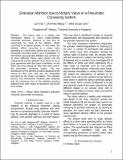| dc.contributor.author | Yao, Jun | |
| dc.contributor.author | Wang, Chi-Hwa | |
| dc.contributor.author | Lim, Wee Chuan | |
| dc.date.accessioned | 2004-12-15T20:17:24Z | |
| dc.date.available | 2004-12-15T20:17:24Z | |
| dc.date.issued | 2005-01 | |
| dc.identifier.uri | http://hdl.handle.net/1721.1/7481 | |
| dc.description.abstract | The rotary valve is a widely used mechanical device in many solids-handling industrial processes. However, it may also be responsible for most of the attrition effects occurring in a typical process. In this study, the attrition effects occurring in a rotary valve operating as a stand-alone device and as part of a pneumatic conveying system were investigated. In the former case granular attrition was carried out at three different rotary valve speeds and the experimental results obtained were found to be in good agreement with the Gwyn correlation. In the latter case three typical air flow rates were used in the pneumatic conveying system. The size distribution of the attrition product obtained at the lowest air flow rate used was not adequately described by the Gwyn correlation. The attrition process and mechanisms involved were analysed and the minimum size of the attrition product obtained from both modes of operations was found to be similar. | en |
| dc.description.sponsorship | Singapore-MIT Alliance (SMA) | en |
| dc.format.extent | 47101 bytes | |
| dc.format.mimetype | application/pdf | |
| dc.language.iso | en | |
| dc.relation.ispartofseries | Molecular Engineering of Biological and Chemical Systems (MEBCS); | |
| dc.subject | rotary valve | en |
| dc.subject | attrition | en |
| dc.subject | granular material | en |
| dc.subject | pneumatic conveying | en |
| dc.title | Granular Attrition due to Rotary Valve in a Pneumatic Conveying System | en |
| dc.type | Article | en |
